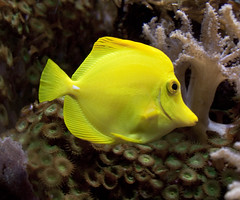Evolutionary taxonomy, records management and fish May 18, 2011
Carol Kaesuk Yoon has written a brilliant book called Naming Nature: The Clash Between Instinct and Science. It’s about scientific taxonomy – the identification and classification of species – but it has so much to say about the theory and process of classification that I think it raises a lot of fascinating issues for our profession as well.
I never realised that we are hard-wired to classify. There is a classification centre in our brain. Yoon argues that we all have this highly evolved sense of ‘umvelt’ – the world around us. And the classification centre in our brain evolved to help us organise and make sense of our own specific ‘umvelt’. Yoon’s book discusses how we evolved this capacity as an essential life skill. Living as hunter-gatherers we needed to define and organise the world around us. That will eat me. I can eat that.
Over millennia, people evolved their capacity to examine, classify and understand their own specific world. But then, the world as each of us individually knew it began to change. It became bigger, more accessible and much more complex. Through travel and expanded communication, people were exposed to more and more plants and animals that challenged their traditional notions and understandings. And then Darwin came along. Evolution turned traditional classifications based on fixed, static groups of plants and animals on their head. Static scientific taxonomies struggled to come to terms with representing the change and shifting relationships through time that are an essential part of evolution.
Methods of classification themselves had to evolve to survive. Traditional taxonomy based on personal, detailed visual analysis of plants and animals was challenged by statistically-based numerical taxonomy and then by evolutionary taxonomy supported by DNA analysis. Using these new ways of seeing and understanding the world, an accurate taxonomy of the natural world based on evolutionary history has begun to take shape. This is an incredible achievement but Yoon argues, in this tremendous victory for science, the real world and our innate understanding of it is being lost.
An example Yoon uses shows why. In the new taxonomies there is no longer a single group of creatures called ‘fish’. ‘Fish’ no longer exist. This is because, according to classification rules, a group or class must be a complete set of descendents from a single ancestor. The problem for fish is that a lot of the life on earth shares the fish’s scaly ancestor. Even we can trace our evolutionary forbears back to the sea. Therefore ‘fish’ as a group have no specific ancestor that is uniquely theirs. Individual fish species have identifiable ancestors and are therefore in the classification, but the broad, aggregate classification of ‘fish’ which has existed in every recorded language group through time and which has formed a key component of every scientific classification of life up till now, is no more.
While thoroughly celebrating science and evolution, Yoon asks what are we losing through rigorous systematising and codifying? As a scientist, Yoon understands and supports why there are no more ‘fish’. But as an individual, she knows that to every non-scientist in the world, ‘fish’ always were and always will be. What is being lost, what is under threat in this clash of ways of seeing?
So this, in a round-a-bout way, sort of brings us back to records. Increasing rigour is also being brought to our profession. We are increasingly and necessarily looking to systematise and codify our practice. As in the scientific community, by necessity, rules rather than personal idiosyncrasies and perceptions are now the standard. But, like the scientists, do we also need to consider what might be being lost in this process?
In each of our organisations, we see problems in implementation all the time. Our own classification structures, our own processes and recordkeeping requirements are poorly accepted and adopted in many environments. Could it be because we too have figuratively eliminated fish? Eliminated the human dimension of what we are dealing with and replaced it purely with science? I have recently also read Steve Bailey’s Managing the Crowd: rethinking records management for the web 2.0 world and in it he talks about crowd sourcing, folksonomies, using the individual viewpoints, experiences and perceptions of the people in our work places to bridge the gap between recordkeeping theory and practice. He argues that our current processes don’t work because they are too separate from both the business and the people that they are designed to support. After reading his and Yoon’s research, I am inclined to agree. Any ideas about what we can do about it?



Dear Kate,
Such an interesting challenge to the rigour of science. Unfortunately I fear that it is not the rigour with which our recordkeeping rules/science are promulgated, but the half-baked application of our understanding, which results in outcomes which are found wanting.
It seems to me that the development of knowledge management came about because there was/is a gap bwetween the formal systems in operation in any organisation and the way people work. Recordkeeping is not different. The challenge for us in the automated/computerised era is weave the application of recordkeeping rules into the way people actually work so the recordkeeping is scarcely visible, ubitiquitous and easy. That’s all!
And while classification is one way humans acquire and process information, the tendency of western thinking to classify by separation – this is not that – is not universal. Yolgnu thinking to build up knowledge of the surrounding world seems to work on the contrary by looking for connections.
Hi Anne – thanks so much for this. Couldn’t agree more!